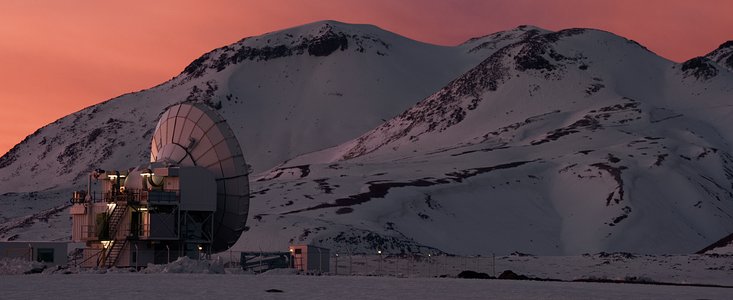Mitteilung
Verlängerung der APEX-Vereinbarung unterzeichnet
12. Mai 2017
Um sicherzustellen, dass ihre produktive Zusammenarbeit bis Ende 2022 fortbesteht, haben die Partner des Atacama Pathfinder Experiments (APEX) eine Verlängerung der Betriebsvereinbarung unterschrieben. Das 12-Meter-APEX-Teleskop sah 2005 erstes Licht und liefert Astronomen detaillierte Bilder der kältesten Objekte und Prozesse im Universum.
APEX ist eine Gemeinschaftsprojekt des Max-Planck-Instituts für Radioastronomie (MPIfR) in Bonn, der ESO und des Weltraumobservatoriums Onsala (OSO) in Schweden. Die Vereinbarung wurde von ESO-Generaldirektor Tim de Zeeuw, von Karl Menten, dem Direktor des Max-Planck-Instituts für Radioastronomie, und von John Conway, Direktor des Weltraumobservatoriums Onsala unterschrieben. Die Zeremonie fand in der Technischen Hochschule Chalmers im schwedischen Göteborg statt.
Im Zuge der APEX-Verlängerungsvereinbarung wird das Teleskop aufgerüstet, um seine Beobachtungs-Gesamteffizienz zu verbessern, und es werden Instrumente der neuen Generation eingesetzt. Zu diesen neuen Instrumenten gehören mehrere Prototypen-Empfänger für ALMA, die neue atmosphärische Fenster öffnen (eso1543) und die Bandbreite bestehender Empfänger erhöhen. Um den hohen Ansprüchen an APEX durch die ESO-Gemeinschaft besser gerecht zu werden, wird der Anteil der ESO von 27 auf 32 Prozent wachsen. Der MPIfR-Anteil wird von 50 auf 55 Prozent steigen, während der Anteil des OSO von 23 auf 13 Prozent sinkt.
APEX wurde für Wellenlängen im Submillimeter-Bereich von 0,2 bis 1,9 Millimetern konzipiert, zwischen Infrarotlicht und Radiowellen – dem Schlüsselbereich für die Entdeckung einiger der kältesten Materialien im Universum. Über die Jahre hat es Licht in viele astronomische Phänomene gebracht: Es hat das wilde frühe Leben der heute massereichsten Galaxien erforscht (eso1206), es untersuchte Materie, die von einem supermassereichen Schwarzen Loch auseinandergerissen wurde (eso0841), und es kartierte die Ebene der Milchstraße bei Wellenlängen im Submillimeter-Bereich (eso1606). Außerdem entdeckte es erstmalig Wasserstoffperoxid-Moleküle im interstellaren Raum (eso1123), löste ein jahrhundertealtes Rätsel einer Sternkarambolage (eso1511) und beobachtete – zusammen mit anderen Teleskopen auf der Welt – das Herz eines weit entfernten Quasars, wobei es Bilder lieferte, die zwei Millionen Mal schärfer sind als das menschliche Auge (eso1229).
Da Strahlung im Submillimeter-Bereich stark vom Wasserdampf in der Erdatmosphäre absorbiert wird, steht APEX in einer Höhe von 5100 Metern auf dem Chajnantor-Plateau in der chilenischen Atacama-Wüste – einem der trockensten Orte der Welt, wo unübertroffene Beobachtungsmöglichkeiten bestehen.
Wie der Name impliziert, ist APEX der Wegbereiter des ALMA-Projekts. Es ist ein leicht veränderter Prototyp einer ALMA-Antenne und wurde am Standort des ALMA-Observatoriums errichtet, das nun selbst voll im Einsatz ist als weltgrößte bodengebundene Einrichtung für Beobachtungen im Millimeter/Submillimeter-Bereich. ALMA umfasst ein riesiges Feld von 54 12-Meter-Antennen und zwölf 7-Meter-Antennen, die – dank der Pionierarbeiten von APEX – transformative Wissenschaft in der Physik des kalten Universums ermöglichen, indem damit die ersten Sterne und Galaxien erforscht werden und die Formation der Planeten direkt im Bild festgehalten wird. Viele der Stärken von APEX, etwa seine Fähigkeit, sehr weite Gebiete zu kartieren, ergänzen ALMA sehr gut.
Mit der Verlängerung der APEX-Vereinbarung bis 2022 wird die europäische Nutzergemeinschaft weiter von der privilegierten Möglichkeit profitieren, sich optimal auf ALMA-Folgeprogramme vorzubereiten, und APEX wird weiterhin das kalte und weit entfernte Universum erforschen – und zweifellos neue aufregende Entdeckungen beisteuern.
Weitere Informationen
APEX ist eine Kooperation zwischen dem Max-Planck-Institut für Radioastronomie (MPIfR), dem Weltraumobservatorium Onsala (OSO) und der Europäischen Südsternwarte (ESO). Das Teleskop wurde von VERTEX Antennentechnik GmbH aus Deutschland entworfen und konstruiert (unter Vertrag mit dem MPIfR), und es basiert auf einem Antennen-Prototypen, der für das ALMA-Projekt gebaut wurde. Mit dem Betrieb von APEX in Chile ist die ESO betraut.
Links
- Mehr über das APEX-Teleskop bei der ESO
- Die APEX-Forschungs-Webseite
- Mehr über ALMA bei der ESO
- Die gemeinsame ALMA-Observatoriums-Webseite
Kontaktinformationen
Peter Grimley
ESO Assistant Public Information Officer
Garching bei München
Tel: 089 3200 6383
E-Mail: pgrimley@partner.eso.org
Über die Mitteilung
| ID: | ann17026 |


